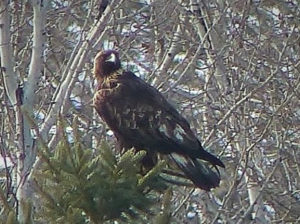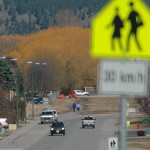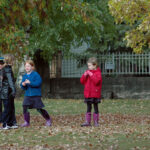Home »

An eye on the sky
 College of the Rockies People: Their Courage, Curiosity, and Contributions
College of the Rockies People: Their Courage, Curiosity, and Contributions
Lakota holy man John Fire Lame Deer (1903-1976), once said, “When you see an eagle, you see all the wisdom in the world.” College of the Rockies’ Philosophy and Sociology instructor, Vance Mattson (pictured right), agrees.
“Eagles are an inspiring creature,” he said. “Typically considered magnificent, they have positive symbolism all over the world.”
Always drawn to nature, the mountains, and wildlife while growing up, first in Hay River, Northwest Territories and then in Springbank, Alberta, Mattson became involved in studying eagles in 2005.
He said, “I was spending so much time exploring the backcountry, it was nice to direct some of this time to a purpose beyond just personal fulfilment.”
Prior to moving to the East Kootenay, Mattson studied psychology, sociology, and philosophy at the University of Wisconsin-Superior on a hockey scholarship. He then continued his education in sociology and philosophy at McGill University on a full academic scholarship. In 1998, he was offered a teaching position at College of the Rockies.
A few years into his stay in the Kootenays, Mattson found himself questioning whether to leave to explore other opportunities. A ski day at Kimberley Alpine Resort helped to solidify his decision to stay put.

“I got to the top of the chairlift and looked up and the Rocky Mountains were spread out before me,” he said. “I knew then that exploring those mountains was my future.”
He first began performing eagle migration work as a volunteer with the Rocky Mountain Eagle Research Foundation (RMERF) in 2005. RMERF’s research director, Peter Sherrington, discovered the largest Golden Eagle flyway in the world along the eastern portion of the Rocky Mountains, which extends from the western U.S. States all the way up to Alaska, and runs through Canmore and the Crowsnest Pass. Peter and his colleagues at the RMERF have been completing migration counts in that region ever since.
In 2007, Mattson moved from volunteer to a principle observer before taking it upon himself to expand the count locations.
“Instead of travelling two hours through the mountains to the Crowsnest Pass, I began to explore the western ranges of the Rockies along the Rocky Mountain Trench near Cranbrook,” he said. “I discovered quickly that we had our own significant golden eagle migration route. Since 2009, when time permits, I have been conducting exploratory counts each year, in both spring and fall.
“North America has just two types of eagles, the well-known bald eagle, and the lesser-known golden eagle,” he explained. “While I am interested in both species, it is the golden eagle that is my primary personal interest and focus of study.”
Preferring mountainous regions with broken terrain, the species is found primarily in the western parts of Canada and the United States. The mountains in B.C. and southwestern Alberta further provide an ideal location for their migration routes, as the steep mountain walls provide updrafts and thermals to assist the eagles on their journey north in spring and south in the fall.
 The population of golden eagles in North America, however, is declining due to habitat loss, vehicle strikes (especially in winter when eagles take advantage of road-killed animals for food), lead poisoning from bullets, wind turbines, and probably still some poaching. The bi-annual migratory counts performed by Mattson and the RMERF provide valuable information that can aid in conservation efforts.
The population of golden eagles in North America, however, is declining due to habitat loss, vehicle strikes (especially in winter when eagles take advantage of road-killed animals for food), lead poisoning from bullets, wind turbines, and probably still some poaching. The bi-annual migratory counts performed by Mattson and the RMERF provide valuable information that can aid in conservation efforts.
As a natural addition to the migration study, Mattson also spearheads a breeding population study which aims to establish a baseline count of the species in our region.
“At present, there is no data on the resident population, and not even reliable estimates,” Mattson said. “So it is exciting to begin to put the pieces of the puzzle together.”
The breeding population study is now in its second year, with financial support being provided this year by the British Columbia Field Ornithologists (BCFO). As golden eagles typically use the same nesting territories each year, establishing data on the resident population will make continual monitoring possible.
“While seeing the golden eagle in its remote and sublime natural habitats is an especially rewarding experience, establishing baseline data will allow us to identify the basic health of the species in our region as well as identify risks to it, and the larger ecosystem,” Mattson said.
For his efforts with the RMERF, Mattson was awarded a lifetime honourary membership.

“The work that Vance has been doing for the past 10 or 11 years has helped to fill in gaps in our knowledge,” said Sherrington. “He’s been more or less doing that single-handedly.”
This is work that the British Columbia Field Ornithologists would like to see continue.
“The BCFO encourages researchers by offering grants to those conducting new research into birds and their environment,” said BCFO vice-president Gary Davidson. “The studies being conducted by Vance and the RMERF are precisely the type of research we encourage. His work is ground-breaking and will almost certainly provide new information to assist in protecting the species and preserving habitat.”
 Mattson encourages anyone interested in helping with the eagle counts, or in expanding count locations to other regions like Creston, to contact either the RMERF or himself at [email protected].
Mattson encourages anyone interested in helping with the eagle counts, or in expanding count locations to other regions like Creston, to contact either the RMERF or himself at [email protected].
Lead image: A soaring golden eagle. Photos submitted
College of the Rockies







